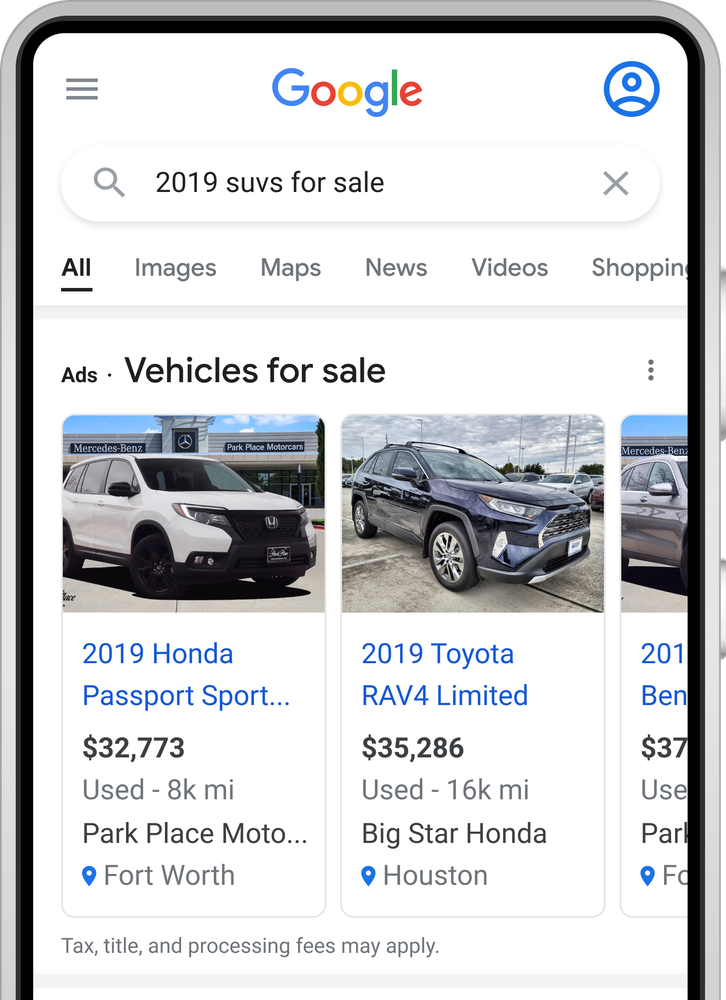This is an archived article and contains information that has not been updated or reviewed since it was originally published. For more information regarding the content in this article, please contact us.
Earlier this month, Google announced a new Google Ads format for advertising vehicles to consumers. The announcement launched automated vehicle ads that are available to all advertisers in the United States, with more countries to be added at a later date. This is a new ad format that is ideal for automotive dealership owners who are looking to appear in Google more easily.
What Are Automated Vehicle Ads
Currently, if you are advertising through Google Ads you would have the choice to run specific campaigns of certain brands of cars that you carry or generic ads that promote your particular dealership. With automated vehicle ads, you can now promote your entire vehicle inventory to potential buyers through Google’s search engine.

These vehicle ads will now show up, automatically, to local users in a dedicated ad section at the top of the search results page. When someone searches for a vehicle, the ads will show an image of the vehicle along with the make, model, price, mileage, and the advertiser’s name. When someone clicks on the ad, they are taken directly to the vehicle’s page on the advertiser’s site. From there, the user can learn more and advertisers can determine which actions on the page they wish to measure as goals. This format is only available for new and used vehicles but not for vehicle accessories, parts, tires, or services.
How to Start Running Automated Vehicle Ads
Advertisers who are looking to take advantage of these new automated vehicle ads first need to have a Google Merchant Centre account. Once you’ve created an account, you can then create a vehicle inventory data feed to promote your entire inventory to potential buyers through Google. That account can then be used to run smart shopping campaigns in Google Ads which will show the vehicle ads.
The platform does have specific guidelines and policies for the images used in the vehicle ads. When you are collecting images to start creating ads, make sure to have images that don’t have watermarks, logos, or texts in them. Google will also decline ads that have placeholder images and possibly modified license plates. Google recommends images that have limited dealership branding, are front-facing, are high quality, and have minimal backgrounds.
Because the information for the ads is pulled from Google Merchant Centre, advertisers will be able to track metrics such as clicks to help gauge performance.
Should you Invest in Running Vehicle Ads?
These ads provide more opportunities for dealerships to create ads that are performance-focused, are omnichannel, and help promote their entire inventory of vehicles. According to Google, 89% of buyers researched their vehicle online before making the purchase. 16% of new car buyers purchased their cars online last year (up from 1% three years prior). This trend will continue to increase, and this new ad format can allow buyers to find, compare, and purchase vehicles more easily.
These new vehicle ads will be visible to potential buyers with high intent which could translate to more conversions. In beta testing, Google says that advertisers who used vehicle ads in conjunction with their existing Search campaign saw a 25% average increase in conversions.
One drawback of this ad format, is that it will almost certainly require an inventory feed that is directly tied in to the dealership inventory system in order to remain compliant with OMVIC (or other regional advertising requirements).
This is an exciting new ad format that we are ready to experiment with for our clients. Vehicle ads are currently in beta testing in Canada and we are patiently waiting for Google to expand this feature to all advertisers.
Interested in being positioned to take advantage of every new opportunity in Google Advertising?


